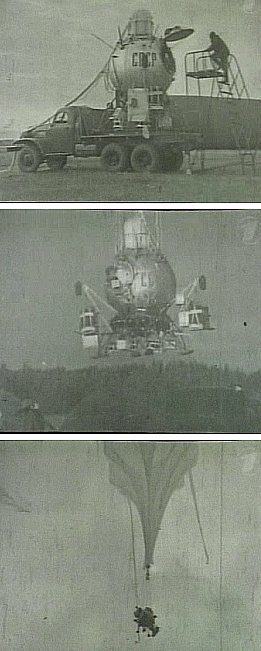 VOLGA (Program)
VOLGA (Program)

Was the name of a manned balloon program carried out by the Soviet Union in the late fifties and early sixties. Like their american counterpart, the StratoLab program, the manned soviet effort used a pressurized gondola and two men crews on each flight. The program was closely tied to the Soviet space program and the design of high altitude aircraft of the time, serving as test platform of escape systems and parachutes to be used by pilots and cosmonauts in case of emergency.
There is no much information available on the subject but apparently in 1958, under the direction of Gennadiy F. Chekalin, where built the firsts gondolas of the program, and the next year started the first unmanned flight tests. The capsule was basically a sphere mounted over a circular platform with eight legs, that counted with two small compartiments one for the commander and the other for the pilot. Almost 5 or 6 capsules were built (some sources say they were as many as ten) for use in ground test, manned and unmanned flights.
The training for the pilots of the program was severe, including the familiarization with the internal panels of the gondola, low level balloon flights to learn how control ascent and descent of a balloon using ballast and tests in altitude chambers. Also several flights to the stratosphere were performed before the final jump, to carefully study emergency procedures, and fine tuning the whole operation.
The operations were carried out from the Volsk airfield, in the Saratov region, close to the Volga river, hence the name as the program was known in the West.
The more famous mission took place there in November 1st, 1962 . At left we can see several images coming from the official footage taken at the airfield in the moment of launch.
Onboard the capsule were Major Yevgenny Andreyev and Colonel Piotr Dolgov, two experienced parachutists that were assigned to the Soviet Air Force's Flight Test Centre since 1950, and later were involved in the program. Andreyev was catapulted succesfully from the capsule at 24.460 meters using an ejector seat system built for the Vostok capsule setting a high altitude free fall world record that still today remains unbeaten. Dolgov should was wearing a full pressure Sokol space suit and jumped on his foots from the capsule a few minutes after Andreyev did. He exited the capsule from 28.640 m but apparently hit the border of the hatch, making a hole of the size of a pin's head on his helmet but big enough to allow the air to escape, depressurising his suit. Althought the automatic parachute system worked well, when Dolgov landed he was dead.
Althought the sad loss, the mission received a widespread press coverage across the Soviet media, with high interest from the people. In december that year, both pilots were awarded with the title of "Hero of the Soviet Union" the highest distinction for heroic feats in service to the Soviet state and society.
According to some sources there were plans for the continuation of the program to try to reach higher altitudes and beat more records, but after the tragic death of Dolgov, a government comission cancelled it.
Nowadays one of the capsules -numbered as 5 in the series- is in display at the Central Air Force Museum in Monino, Moscow.

